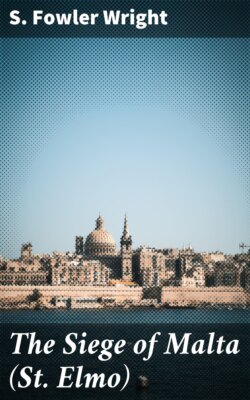Читать книгу The Siege of Malta (St. Elmo) - S. Fowler Wright - Страница 3
На сайте Литреса книга снята с продажи.
FOREWORD
ОглавлениеTable of Contents
It was in the last year of his life, and in broken health, that Sir Walter Scott visited Malta, with the double purpose of avoiding the rigour of the northern winter and collecting material for a contemplated romance on the siege of Malta. During that time he was without the clerical assistance to which he had become accustomed, and both his Journal and the MS. of this projected book were written with a hand over which he had lost full control.
Lockhart, into whose possession the MS. came at his death, condemned it lightly as illegible nonsense, and that verdict naturally prevailed so long as its author’s reputation for judgment and veracity remained unshaken.
But the fact that the entries in the Journal, made during the same period, have been deciphered, created a presumption that the MS. of the Siege of Malta[A] would be equally legible; and the further fact that those entries are very far from nonsense and show Scott’s intellect to have had, at the least, intermittent vigour (they include saner and more accurate estimates of his business position and prospects that his son-in-law was afterwards to present) suggested the possibility that it might not be wasted labour to discover what the Siege of Malta really was.
In the pursuit of this object, I traced the ownership of the MS. and its copyright to Mr. Gabriel Wells, who gave me an opportunity of inspecting it when in New York, and to whom it is a pleasure to express my gratitude, not merely for giving access to it, but for the courteous generosity of his permission to use it as the foundation of this romance.
The original MS. consists of about 75,000 words. It contains the opening scenes, and one or more later episodes, very much as they now appear. Beyond that, it is mainly an account of the Siege of Malta, which it follows to its conclusion. It is frequently inaccurate and repetitions are numerous.
When Scott started home from Naples on his last journey, in the hope of recovered health (Lockhart’s suggestion that he hurried back with a premonition that death was near is not merely a doubtful guess, it is clearly disproved by Scott’s own statements and by the leisurely nature of the first part of the journey) he sent this MS. to Abbotsford by sea, to await his arrival; and there is at least one reference by which he appeared to regard it as a finished work.
If he did so, it was a mistake; and had it been published in such a form it must have been a grotesque failure. But it is far more probable, as evidenced by its substance and brevity, that he considered it rather as the historical skeleton on which he would construct a complete romance in the leisure of the succeeding summer.
The short months in Malta had been used for the accumulation of historical material, and in this sense the brief MS. which he had written with his half-palsied hand had finished what he required. The opening scenes were sketched out: the historic background was complete. The romance itself could be dictated (as had become his method for creative work during several previous years) in the summer peace of his Abbotsford library.
The probability of this theory is increased by the nature of the defects of the MS. in its present form. Had it a weak or confused plot, it might be more reasonable to accept Lockhart’s suggestion that it was an abortion of failing powers. But the more curious fact is that it has none. After the opening chapters, Angelica (for instance) is not mentioned at all. She fades out; and Francisco soon follows her into a similar silence. The MS. becomes nothing more than a picturesque account of the siege of Malta, vigorous in parts, but with the defects and repetitions that such a draft, so written and unrevised, would be likely to have. Whatever might have happened had Scott lived for another year, it may be asserted with entire confidence that he would not have published it in its present condition.
Its form being thus, it became natural to examine it carefully for any indications of the plot which Scott had designed to use, and this resulted in the discovery of one slight but probably significant clue.
The account of the visit of the Maltese envoy to Don Manuel, with which the story opens, contains no suggestion that he is other than he professes, unless it be in the remark of a boatman whom he first approaches, that he has the look of a heathen Moor, and in some petulance on Don Manuel’s part at the medium of communication that the Grand Master had chosen. Neither of these is at all conclusive, as a genuine Maltese might have given such an impression to an Andalusian boatman, and Don Manuel would have had a similar ground of complaint against the genuine messenger. But in a later part of the MS. there is an incidental allusion to the envoy “said to have been a herald at some college of arms,” as a man under suspicion of being a traitor to the Maltese cause. It is an allusion without consequence, the herald not being mentioned again, but it is obviously suggestive, and it is on the pregnant implications of that phrase, and the foundations supplied by the master of historical romance, that I have ventured to build this tale.
S. Fowler Wright.
[A] In his Journal, Scott uses the titles “Siege of Malta” or “Knights of Malta,” indifferently, and I have followed this precedent.
